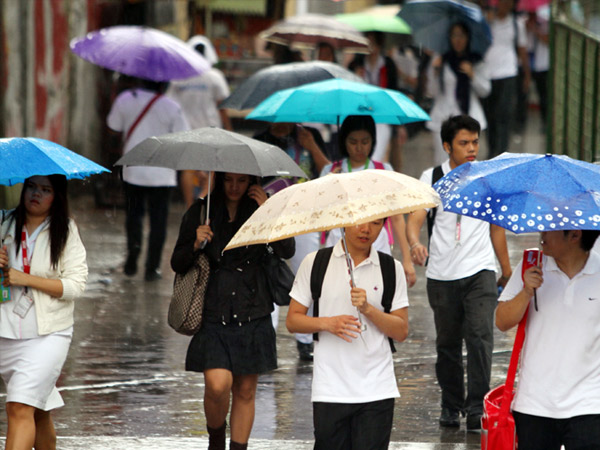The good news is that the rainy season has officially begun after months of drought.
The bad news is the rains will last only three months and will be cut short by a “moderate to strong” El Niño in the last quarter of the year.
The Philippine Atmospheric, Geophysical Astronomical Services Administration (Pagasa) announced on Tuesday the start of the rainy season in the western section of the country after prevalent rains were recorded over the weekend.
READ: Pagasa declares start of rainy season; 11-16 more cyclones before yearend
“Intermittent to continuous rains and thunderstorms associated with the southwest wind flow will affect Metro Manila and the western section,” Pagasa said.
At the same time, the state weather agency said that “breaks in rain events” lasting for several days to weeks would be experienced “due to the persistence of the ridge of the north Pacific high pressure area.”
Full impact
Pagasa was, however, quick to warn of a return of dry conditions, saying the current weak El Niño would intensify from moderate to strong from October to December this year.
From July to September, most of Luzon and the Visayas will still receive normal to above normal rainfall, according to Pagasa climatologist Anthony Lucero.
“We’ll experience the full impact of El Niño in the last quarter of the year from October to December. Most areas in the country will have below normal rainfall,” he warned.
Drought in 17 provinces
Lucero said major dams and river basins would reach critical levels owing to reduced rainfall.
Angat Dam, which supplies most of Metro Manila’s domestic water needs, will likely recover its normal operating level of 210 meters above sea level in the next three months, before the level goes down again during the El Niño months, Pagasa said.
Despite the onset of the rainy season, Pagasa said 17 provinces would continue to suffer from drought, or dry spell conditions, in July. Thirty-one other affected provinces will get some respite from the rains.
“Latest rainfall analysis showed that below normal rainfall conditions were experienced in many parts of the country,” Pagasa said in its latest El Niño bulletin.
11 to 16 cyclones
El Niño was blamed for the delay in the start of the rainy season, which usually starts between the second week of May and the first week of June.
Even the arrival of typhoons was delayed, with no tropical storm hitting the country this month. The country usually gets one to two storms in June.
Pagasa, however, still expects the country to be hit by 11 to 16 tropical storms the rest of the year. Due to El Niño, the storms may be fewer but more intense, it said.
Pagasa said slightly warmer than normal temperature would be experienced during the El Niño period.
“This El Nino episode may gradually weaken in the early months of 2016 and may likely terminate by May 2016,” it said.
El Niño is a weather phenomenon characterized by an unusual warming of sea surface temperatures in the Pacific Ocean.
Pagasa said the prevailing intertropical convergence zone across Mindanao would bring light to moderate rains on Wednesday over Mindanao, western and central Visayas and Palawan province.
RELATED STORIES
‘Tis ‘almost’ the rainy season — Pagasa
